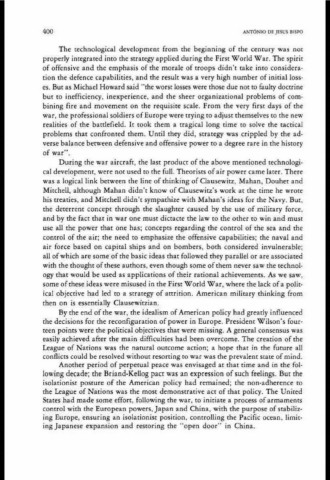Page 434 - 1992 - XVIII Congresso Internazionale di Storia Militare
P. 434
400 ANTONIO LlE JliWS 1\ISPO
Tbe technological developmem from che beginnjng of che cenrury was not
properly inregrated into the strategy applied during the Fim World War. The spirit
of offensive and che emphasis of the morale of troops di d n t rake into considera·
'
cion the defence capabilities, and the resulc was a very high number of initialloss·
es. Bue as Michael Howard said "the worsr losscs were those due noc co fauJcy docrrine
bue co ineffìçjency, inexperience, and che shc:er organizational problems of com·
bining fire and movement on che requisite scale. From che vcry firsr days o( the
war, the professional so'ldiers of Europe were trying co adjusc chemselves co the new
realicies of che barclefìeld. lt cook them a rragical long tjme to solve the t.actical
problems thac confronted them. Uncil they did, srraregy was crippled by the ad·
verse balance becween defensive aod offensjve power t0 a degcee rare in che history
of war".
During che war aircraft, rhe laH produce of the above mencioned t{:chnologi·
ca l development, were noc used co the full. Theorists of air power carne larer. Theu
was a logica11ink becween rhe fine of thinking of Oausewirz, Mahan, Douhet and
MitcheU, although Ma han d id n't know of Clausewirz's work at che cime he wroce
his treaties, and MiccheU djdn'c sympathize with M.ahan's ideas for the Navy. Bue,
che dererreoc concepr through the slaughter caused by che use of military force,
aod by the fact that in war one musr dicraa:e the la w co the other ro win an d musr
use ali the power that one has: concep~ regarding the comrol of the sea and che
contro! of the ajr; the need to emphasize rhe offensive capabilities; me naval and
air force based on capira1 ships and on bombers, both considered invulnerable:
a1l of which are some of the basic idea!> ma c followed rhey paralle1 or are associared
w i rh the thoughr of che se authors, even though some of them never sa w the rechnol·
ogy that would be used as applications o( rheir rational achievemenrs. As. we saw,
some of these ideas were rrusused in the Fitsr World War, whece the lack of a polit·
ical objective had led ro a srrategy of amirion. American milicary thinking &om
then on is essenciaUy Clausewitzian.
By che end of the war, the idea1ism of American policy had gready influenced
che decisions for the recoofiguration of power in Europe. Presi.deor Wilson's four·
teen poims were che policical objecrives thar were missing. A generai. consensus was
easil}' achieved afrer the mai n difficu1ties had been overcome. The creacion of the
League of Naòons was the narura1 outcome aaion: a hope thar in rhe future ali
conflicrs could be resolved without resorcing co war was the prevalenc stare of mi.nd.
Anocher peri od of perperua1 peace was envisaged at that rime and in the fol·
Jowing decade; the Briand-Kellog pact was an expression of such feelings. But che
isolacionisr posrure of rhe American policy bad remained: che non-adhereoce ro
the League of Nations was rhe mosr demonstradve aa of that policy. The Unired
Star es ha d m ade some. effon, foUowiog the war, co io i riace a process of a.rmamenrs
contro! with the Europeao powers, Japan and Chjna, with the purpose of scabiliz·
ing Europe, ensuring an isolatiorust posidon, controlling the Pacific ocean, limit·
ing Japanese e:xpansion and tescoring the "open door" in China.

